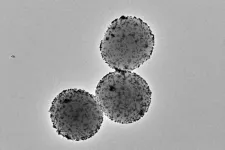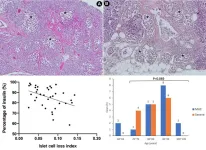(Press-News.org) Over the last decades, air pollution emissions have decreased substantially; however, the magnitude of the change varies by demographics, according to a new study by Columbia University Mailman School of Public Health. The results indicate there are racial/ethnic and socioeconomic disparities in air pollution emissions reductions, particularly in the industry and energy generation sectors. The findings are published in the journal Nature Communications.
The research provides a national investigation of air pollution emission changes in the 40 years following the enactment of the Clean Air Act (CAA). Until now, studies have primarily focused on evaluating air pollution disparities at a single time point, focusing on pollutant concentrations instead of emissions. A focus on emissions, however, has more direct implications for regulations and policies. In this study, the researchers used county-level data to evaluate racial/ethnic and socioeconomic disparities in air pollution emissions changes in the contiguous U.S. from 1970 to 2010.
“The analyses provide insight on the socio-demographic characteristics of counties that have experienced disproportionate decreases in air pollution emissions over the last forty years,” said Yanelli Nunez, PhD, the study’s first author, who is a scientist in the Department of Environmental Health Sciences at Columbia Mailman School of Public Health and affiliated with PSE Healthy Energy. Additionally, by analyzing air pollution emissions, the researchers identified specific pollution source sectors that are potentially important contributors to air pollution exposure disparities.
Nunez and colleagues leveraged air pollution emissions data from the Global Burden of Disease Major Air Pollution Sources inventory to analyze air pollutant emissions from six pollution source sectors: industry (sulfur dioxide), energy (sulfur dioxide and nitrogen oxides), agriculture (ammonia), on-road transportation (nitrogen oxides), commercial (nitrogen oxides), and residential (particles of organic carbon).
On average, national U.S. air pollution emissions declined substantially from 1970 to 2010 from all source sectors the researchers considered except for ammonia emissions from agriculture and organic carbon particle emissions from the residential sector, which the researchers indicate is primarily from using solid biofuels for indoor heating. The most pronounced emission decreases were observed for sulfur dioxide from industrial and energy generation activities. Nitrogen oxide emissions from transportation, commercial activities, and energy generation decreased moderately.
Despite the overall downward trends for most pollutants, the researchers found that certain populations experienced relatively smaller reductions or even increases in air pollution emissions. For instance, an increase in a county's average Hispanic or Indian American population percentage resulted in a relative increase in sulfur dioxide, nitrogen oxides, and ammonia emissions from the industry, energy generation, and agriculture sectors, respectively. Additionally, an increase in the county median family income was linked with an increase in the magnitude of emissions reductions in every pollution source sector the researchers analyzed, except agriculture.
“Air pollution emissions do not perfectly capture population air pollution exposure, and we also know that neighborhood-level air pollution inequities are common, which we were not able to analyze in this study given the data at hand,” noted Marianthi-Anna Kioumourtzoglou, ScD, associate professor of environmental health sciences at Columbia Mailman School, and senior author. “In this study, we provide information about potential racial/ethnic and socioeconomic inequalities in air pollution reductions nationwide from major air pollution sources, which can inform regulators and complement local-level analysis.”
“Policies specifically targeting reductions in overburdened populations could support more just reductions in air pollution and reduce disparities in air pollution exposure,” observed Dr. Nunez. “This is an important lesson gained from 53 years of Clean Air Act implementation, which is particularly relevant as we develop policies to transition to renewable energy sources, which will have a collateral impact on air quality and, as a result, on public health.”
Co-authors are Jaime Benavides, Jenni A. Shearston, Misbath Daouda, and Jeff Goldsmith, Columbia University Mailman School of Public Health; Joan Casey, Columbia Mailman School and the University of Washington; Elena Krieger, PSE Healthy Energy; Lucas R.F. Henneman, George Mason University; and Erin McDuffie, University of Washington.
The study was supported by National Institute of Environmental Health Sciences, (P30 ES009089, R01 ES030616, R01 ES028805 and T32 ES007322), The Thomas F. and Kate Miller Jeffress Memorial Trust, Bank of America; and Health Effects Institute (HEI, R-82811201).
Columbia University Mailman School of Public Health
Founded in 1922, the Columbia University Mailman School of Public Health pursues an agenda of research, education, and service to address the critical and complex public health issues affecting New Yorkers, the nation and the world. The Columbia Mailman School is the fourth largest recipient of NIH grants among schools of public health. Its nearly 300 multi-disciplinary faculty members work in more than 100 countries around the world, addressing such issues as preventing infectious and chronic diseases, environmental health, maternal and child health, health policy, climate change and health, and public health preparedness. It is a leader in public health education with more than 1,300 graduate students from 55 nations pursuing a variety of master’s and doctoral degree programs. The Columbia Mailman School is also home to numerous world-renowned research centers, including ICAP and the Center for Infection and Immunity. For more information, please visit www.mailman.columbia.edu.
END
U.S. air pollution rates on the decline but pockets of inequities remain
Decreases more substantial in high-income neighborhoods
2024-01-15
ELSE PRESS RELEASES FROM THIS DATE:
New Scientific Reports publication reveals major difference in genomes of American and Chinese chestnut
2024-01-15
The chromosomes of American and Chinese chestnut are not so similar after all, at least in one key region of the genome – the nucleolus organizing region (NOR).
The finding, published in a forthcoming article in Scientific Reports, has major implications for anyone with the goal of conferring blight-resistance to American chestnuts through hybridization with the Chinese chestnut.
“This is an unprecedented finding in the field of plant cytology,” says Nurul Faridi, a Forest Service geneticist and lead author of the study.
Traditional ...
Solid-state qubits: Forget about being clean, embrace mess
2024-01-15
New findings debunk previous wisdom that solid-state qubits need to be super dilute in an ultra-clean material to achieve long lifetimes. Instead, cram lots of rare-earth ions into a crystal and some will form pairs that act as highly coherent qubits, shows paper in Nature Physics.
Clean lines and minimalism, or vintage shabby chic? It turns out that the same trends that occupy the world of interior design are important when it comes to designing the building blocks of quantum computers.
How to make qubits that retain their quantum information long enough to be useful is one of the major barriers to practical quantum computing. It’s widely accepted that the ...
Bladder tumors reduced by 90% using nanorobots
2024-01-15
Bladder cancer has one of the highest incidence rates in the world and ranks as the fourth most common tumour in men. Despite its relatively low mortality rate, nearly half of bladder tumours resurface within 5 years, requiring ongoing patient monitoring. Frequent hospital visits and the need for repeat treatments contribute to making this type of cancer one of the most expensive to cure.
While current treatments involving direct drug administration into the bladder show good survival rates, their therapeutic efficacy remains low. A promising alternative involves the use of nanoparticles capable of delivering therapeutic agents directly to the tumour. ...
Research sheds new light on Moon rock formation solving major puzzle in lunar geology
2024-01-15
New research has cracked a vital process in the creation of a unique rock type from the Moon. The discovery explains its signature composition and very presence on the lunar surface at all, unravelling a mystery which has long eluded scientists.
The study, published today in Nature Geoscience, reveals a key step in the genesis of these distinctive magmas. A combination of high temperature laboratory experiments using molten rocks, together with sophisticated isotopic analyses of lunar samples, identify a critical reaction that controls their composition.
This reaction took place in the deep lunar interior some three and a half ...
Priming, shaping and polishing: In search of a HIV vaccine
2024-01-15
Worldwide, an estimated, 40 million people live with HIV. Two-thirds of this group on the African continent. In 2022, more than 600,000 people died from HIV-related causes and more than 1.3 million were infected. There is no vaccine against the world's second most deadly infection, after TB. Thanks to a grant from the Bill & Melinda Gates Foundation, Amsterdam UMC's Rogier Sanders leads a project that aims to develop the first effective HIV vaccine.
"We hope to be able ...
Vigilant monitoring is needed to manage cardiac risks in patients using antipsychotics, doctors say
2024-01-15
Philadelphia, January 15, 2024 – The use of the antipsychotic drugs quetiapine and haloperidol is associated with an increased risk of ventricular arrhythmias and sudden cardiac death (SCD) caused by drug-induced QT prolongation, reports a new study in Heart Rhythm, the official journal of the Heart Rhythm Society, the Cardiac Electrophysiology Society, and the Pediatric & Congenital Electrophysiology Society, published by Elsevier. Caution is advised to manage cardiac risks in patients prescribed ...
Singapore study reveals impact of early life adversity on a child’s brain development
2024-01-15
Leveraging neuroimaging data from the Growing Up in Singapore Towards healthy Outcomes (GUSTO) cohort, researchers from A*STAR’s Singapore Institute for Clinical Sciences (SICS) identified an association between early life adversity and the pace of brain development in childhood.
SINGAPORE – A study led by researchers from A*STAR's Singapore Institute for Clinical Sciences (SICS) has found evidence suggesting that children exposed to elevatec levels of early life adversity (ELA) exhibit an accelerated pattern of brain development during the preschool years. When exposed to ELA, such as a mother's mental and ...
Researchers propose revised scoring system for recognising outstanding NHS clinicians
2024-01-15
A team of researchers has developed a new scoring system for a nationwide scheme, overseen by the Advisory Committee on Clinical Impact Awards (ACCIA), to recognise and reward senior doctors and dentists in England and Wales.
There has been a scheme in place since 1948 to reward senior clinicians who make an outstanding contribution to supporting the delivery of NHS goals. The awards have been known, through various iterations, as merit awards, clinical excellence awards, and, most recently, clinical impact awards.
Published ...
Few older adults use direct-to-consumer health services; many who do don’t tell their regular provider
2024-01-14
Only a small percentage of older Americans have jumped on the rising trend of getting health care services and prescriptions directly from an online-only company, rather than seeing their usual health care providers in person or via telehealth, a new poll finds.
But that could change rapidly, the University of Michigan survey suggests.
In all, 7.5% of people between the ages of 50 and 80 have used at least one direct-to-consumer health care service from an online-only provider, according to the new findings from the National Poll on Healthy Aging.
Of those who did ...
Loss of cells in pancreas in the elderly may cause age-related diabetes
2024-01-13
Tokyo, Japan – Researchers from Tokyo Metropolitan University have studied pancreatic islet cell loss in people with no previous pancreatic problems. They identified key trends in the types of cells lost due to islet cell loss in different age groups and sexes, finding that ICL in the elderly population was largely due to insulin-producing beta cell loss. This may be the cause of age-related diabetes and help inform new preventative treatments.
The pancreas is an incredibly important part of the human digestive system, particularly for regulating blood sugar levels by secreting the hormone insulin. ...
LAST 30 PRESS RELEASES:
Pure bred: New stem cell medium only has canine components
Largest study of its kind highlights benefits – and risks – of plant-based diets in children
Synergistic effects of single-crystal HfB2 nanorods: Simultaneous enhancement of mechanical properties and ablation resistance
Mysterious X-ray variability of the strongly magnetized neutron star NGC 7793 P13
The key to increasing patients’ advance care medical planning may be automatic patient outreach
Palaeontology: Ancient tooth suggests ocean predator could hunt in rivers
Polar bears may be adapting to survive warmer climates, says study
Canadian wildfire smoke worsened pediatric asthma in US Northeast: UVM study
New UBCO research challenges traditional teen suicide prevention models
Diversity language in US medical research agency grants declined 25% since 2024
Concern over growing use of AI chatbots to stave off loneliness
Biomedical authors often call a reference “recent” — even when it is decades old, analysis shows
The Lancet: New single dose oral treatment for gonorrhoea effectively combats drug-resistant infections, trial finds
Proton therapy shows survival benefit in Phase III trial for patients with head and neck cancers
Blood test reveals prognosis after cardiac arrest
UBCO study finds microdosing can temporarily improve mood, creativity
An ECOG-ACRIN imaging study solves a long-standing gap in metastatic breast cancer research and care: accurately measuring treatment response in patients with bone metastases
Cleveland Clinic presents final results of phase 1 clinical trial of preventive breast cancer vaccine study
Nationally renowned anesthesiology physician-scientist and clinical operations leader David Mintz, MD, PhD, named Chair of the Department of Anesthesiology at the UM School of Medicine
Clean water access improves child health in Mozambique, study shows
Study implicates enzyme in neurodegenerative conditions
Tufts professor named Fellow of the National Academy of Inventors
Tiny new device could enable giant future quantum computers
Tracing a path through photosynthesis to food security
First patient in Arizona treated with new immune-cell therapy at HonorHealth Research Institute
Studies investigate how AI can aid clinicians in analyzing medical images
Researchers pitch strategies to identify potential fraudulent participants in online qualitative research
Sweeping study shows similar genetic factors underlie multiple psychiatric disorders
How extreme weather events affect agricultural trade between US states
Smallholder farms maintain strong pollinator diversity – even when far from forests
[Press-News.org] U.S. air pollution rates on the decline but pockets of inequities remainDecreases more substantial in high-income neighborhoods




